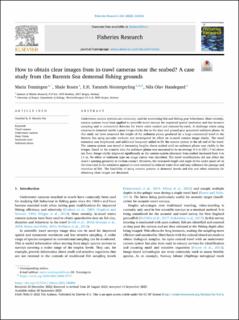| dc.contributor.author | Tenningen, Maria | |
| dc.contributor.author | Rosen, Shale | |
| dc.contributor.author | Westergerling, Eugenie Heliana Taraneh | |
| dc.contributor.author | Handegard, Nils Olav | |
| dc.date.accessioned | 2023-10-17T07:38:37Z | |
| dc.date.available | 2023-10-17T07:38:37Z | |
| dc.date.created | 2023-10-13T12:45:08Z | |
| dc.date.issued | 2023 | |
| dc.identifier.citation | Fisheries Research. 2023, 268 . | |
| dc.identifier.issn | 0165-7836 | |
| dc.identifier.uri | https://hdl.handle.net/11250/3096856 | |
| dc.description.abstract | Underwater camera systems are commonly used for monitoring fish and fishing gear behaviours. More recently, camera systems have been applied to scientific trawl surveys for improved spatial resolution and less invasive sampling and to commercial fisheries for better catch control and reduced by-catch. A challenge when using cameras in demersal trawls is poor image clarity due to the door and ground gear generated sediment plume. In this study we have measured the height of the sediment plume produced by a large commercial trawl in the Barents Sea using acoustic methods and investigated its effect on in-trawl camera image clarity. The trawl extension was lengthened, and additional buoyancy added to lift the camera system in the aft end of the trawl. The camera system was tested at increasing heights above seabed until no sediment plume was visible in the images. Based on the acoustic data the sediment plume was measured to be on average 4–5 m (SD 1.7 m) above sea floor. Image clarity improved significantly as the camera system clearance from seabed increased from 4 to 11 m. No effect of sediment type on image clarity was identified. The trawl modifications did not affect the trawl’s opening geometry or bottom contact. However, the increased length and angle of the under panel aft in the trawl and in the extension appears to have resulted in reduced water flow and may influence the passage and retention of fish. The feasibility of using camera systems in demersal trawls and this and other solutions for obtaining clear images are discussed. | |
| dc.description.abstract | How to obtain clear images from in-trawl cameras near the seabed? A case study from the Barents Sea demersal fishing grounds | |
| dc.language.iso | eng | |
| dc.relation.uri | https://crimac.no/nyheter/new-crimac-article-in-fisheries-research | |
| dc.title | How to obtain clear images from in-trawl cameras near the seabed? A case study from the Barents Sea demersal fishing grounds | |
| dc.title.alternative | How to obtain clear images from in-trawl cameras near the seabed? A case study from the Barents Sea demersal fishing grounds | |
| dc.type | Peer reviewed | |
| dc.type | Journal article | |
| dc.description.version | publishedVersion | |
| dc.source.pagenumber | 9 | |
| dc.source.volume | 268 | |
| dc.source.journal | Fisheries Research | |
| dc.identifier.doi | https://doi.org/10.1016/j.fishres.2023.106856 | |
| dc.identifier.cristin | 2184446 | |
| dc.relation.project | Norges forskningsråd: 309512 | |
| cristin.ispublished | true | |
| cristin.fulltext | original | |
| cristin.qualitycode | 1 | |
